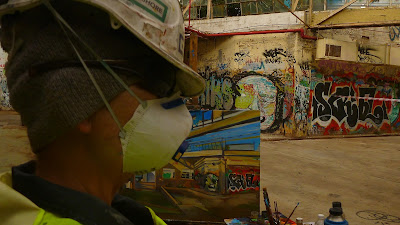A palimpsest is a manuscript or piece of writing material on which later writing has been superimposed on effaced earlier writing.
The
word is also used for something worked upon for one purpose and later
reused or altered but still bearing visible traces of its earlier form.
I've recently been painting both inside and outside the abandoned Dunlop-Slazenger factory in Alexandria.
It has been abandoned for about 25 years, and has innumerable layers of
graffiti ranging from the sublimely talented to the ridiculously inept.
 |
| Painting "Yellow Eye" oil on canvas 75 x 100cm in the abandoned Dunlop-Slazenger factory |
The walls of the abandoned Dunlop-Slazenger Factory are a palimpsest - a fascinating mix of both creation and destruction.
 |
| Painting "Yellow Eye" oil on canvas 75 x 100cm in the abandoned Dunlop-Slazenger factory |
It's an insight into the way different generations alter the landscape of their ancestors.
 |
| Painting "Yellow Eye" oil on canvas 75 x 100cm in the abandoned Dunlop-Slazenger factory |
The factory is full of ghosts.
 |
| Painting "Yellow Eye" oil on canvas 75 x 100cm in the abandoned Dunlop-Slazenger factory |
On the second day of painting this canvas, I changed the composition to include the bizarre cartoon characters on the upper walls.
There is a grotesque creature which is part baboon part wildebeast and part crocodile with wriggling worm-like hair, and two characters resembling demonic smurfs.
The glass has also been tagged, and the rays of the setting sun make it light up like the stained glass of Chartres cathedral.
 |
| Painting "Yellow Eye" oil on canvas 75 x 100cm in the abandoned Dunlop-Slazenger factory |
The building is now being sand-blasted back to the original brick and will be redeveloped for apartments.
 |
| Painting "Yellow Eye" oil on canvas 75 x 100cm in the abandoned Dunlop-Slazenger factory |
Such is progress, alas.
 |
| Painting "Yellow Eye" oil on canvas 75 x 100cm in the abandoned Dunlop-Slazenger factory |
My extremely fashionable painting outfit. Lady Gaga will be copying this soon!
 |
| Painting "Yellow Eye" oil on canvas 75 x 100cm in the abandoned Dunlop-Slazenger factory |
Painting in PPE (Personal protective equipment)
 | |
| DS3 'Greeblies' - Abandoned Dunlop-Slazenger factory' 2015 oil on canvas 122 x 122cm | |
Related posts
Illuminated manuscripts and stained glass windows- Painting the Dunlop - Slazenger factory Part 2






.JPG)







%2Bcrop.jpg)





